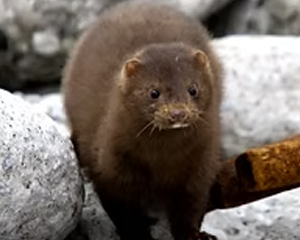Mink - Commonly Trapped Furbearer
UTILIZING OUR ABUNDANT MISSOURI WILDLIFE

Mink
Fast Facts
- Length: 20-30 inches (male); 16-21 inches (female)
- Weight: Male over ~3 lbs; Female ~1½-2 lbs
- Teeth: 34
- Mating Season: Late February – March
- Gestation: 40-75 days (delayed implantation)
- Litter Size: ~4 young (one litter/yr typical)
- Life Span: Up to ~7 years
- Significant Behavior: Excellent swimmer/climber, often along muskrat habitat
Wild mink are adaptable to a wide range of climates, and this species is far more common than most people realize. Efficient predators, mink are quick on land, skilled swimmers, and capable tree climbers. They are often found in habitat types suitable for muskrats, and they are often taken in traps set for muskrats. Mink are usually shy, but they can become bold when their curiosity is aroused. Mink are not sociable with others of their kind — except during the breeding season — and avoidance or fighting between mink is common. :contentReference[oaicite:0]{index=0}
Description
Mink have 34 teeth, with four prominent canine teeth to help in the killing of prey species. Mink have rather long and supple bodies with relatively short legs. There are five toes on each foot that have partial webbing. Tails are fully furred. :contentReference[oaicite:1]{index=1}
Males are larger than females. Males are 20-30 inches long, and females measure 16-21 inches. Male weights exceed 3 pounds in many areas, and females usually weigh 1½-2 pounds. Mink fur is short and dense. Shades of color vary somewhat according to region and individuals. Most shades of color are chocolate to almost black. Patches of white fur are typical on the chins of most mink, and many mink exhibit patches of white fur on throats, chests, and bellies. In some areas, occasional mink have a light colored and wooly underfur. These pelts are referred to as “cotton” mink, and these pelts have lesser value. Mink glands are present near the anal area under the skin of both male and female mink. Musk is sometimes released when the mink is excited or stressed. The odor is powerful and unpleasant. :contentReference[oaicite:2]{index=2}
Reproduction
Breeding occurs over much of the mink range during late February or early March. Males attempt to find several females during this short season. The males usually abandon the females after breeding takes place. Females have one litter per year, usually raising about four young. Gestation times vary from 40 to 75 days due to a delayed implantation process. :contentReference[oaicite:3]{index=3}
Females raise their young entirely by themselves. Dens in abandoned muskrat dens, hollow logs, and rock piles are common. Mink do not usually dig their own dens, but they sometimes burrow into exposed muskrat and beaver lodges above the waterline for denning purposes. Many female mink seem to seek out secluded ponds or small streams with an abundant food supply and good protection to raise their young. :contentReference[oaicite:4]{index=4}
Habits
Male mink have territories or ranges much larger than females. Males seem to be constantly on the move, covering miles in a single day. Females often restrict their travels at night to 20 acres or so in marsh habitats, and they seldom travel farther than 100 yards up- or downstream from their dens near rivers or creeks. The males seem to have routes that might cover 25 miles or more. These males have any number of dens that they use when they are in the area or feel like resting. It appears that males commonly store food in some of these dens for later use. :contentReference[oaicite:5]{index=5}
Many trappers think males return from their travels about once a week and follow nearly the exact same route, crossing streams at the same places and investigating the same brush piles or undercut banks for food. Holes, hollow logs, rock piles, and brush piles interest many mink as protected places to hunt. :contentReference[oaicite:6]{index=6}
Range
Mink are found from the edge of the tundra across Canada and Alaska to Florida, Texas, and California. This species might be absent in Arizona. :contentReference[oaicite:7]{index=7}
General
Mink are usually shy and avoid humans, but at times, they exhibit boldness when their curiosity is triggered. Although mink are sometimes found traveling or living far from water, most prefer the habitats found along the shores of streams, lakes, marshes, canals, and ponds. Mink usually hug the shores as they travel and prefer staying on dry land when they have a choice. At times, an obstacle such as a protruding rock or log may cause the mink to detour into the water. :contentReference[oaicite:8]{index=8}
Mink are preyed upon by owls, fox, coyotes, bobcats, and dogs. Internal parasites include flukes, roundworms, and tapeworms. External parasites include fleas, ticks, and lice. Mink are vulnerable to distemper, parvo enteritis, encephalitis, and rabies. A 7-year-old mink is considered old, and worn teeth are an indication of age. :contentReference[oaicite:9]{index=9}
Contact Missouri Trappers Association
Get in touch with the Missouri Trappers Association by filling out the contact form. We appreciate your support!
For questions regarding your membership, please call
Joslyn Search: (660)292-1911


